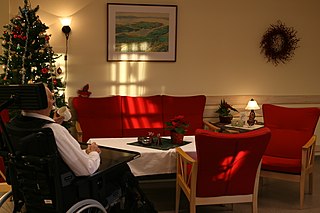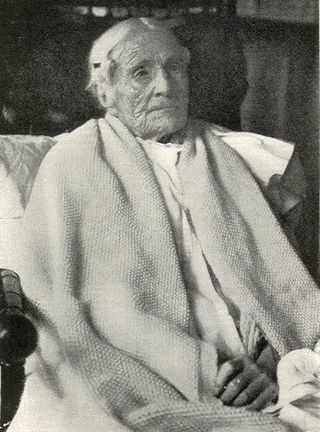
A design is a concept of or proposal for an object, a process, or a system. Design refers to something that is or has been intentionally created by a thinking agent, though it is sometimes used to refer to the nature of something - its design. The verb to design expresses the process of developing a design. In some cases, the direct construction of an object without an explicit prior plan may also be considered to be a design. A design is expected to have a purpose within a certain context, usually has to satisfy certain goals and constraints, and to take into account aesthetic, functional, economic, environmental or socio-political considerations. Typical examples of designs include architectural and engineering drawings, circuit diagrams, sewing patterns and less tangible artefacts such as business process models.

Anthropometry refers to the measurement of the human individual. An early tool of physical anthropology, it has been used for identification, for the purposes of understanding human physical variation, in paleoanthropology and in various attempts to correlate physical with racial and psychological traits. Anthropometry involves the systematic measurement of the physical properties of the human body, primarily dimensional descriptors of body size and shape. Since commonly used methods and approaches in analysing living standards were not helpful enough, the anthropometric history became very useful for historians in answering questions that interested them.

Gerontology is the study of the social, cultural, psychological, cognitive, and biological aspects of aging. The word was coined by Ilya Ilyich Mechnikov in 1903, from the Greek γέρων (gérōn), meaning "old man", and -λογία (-logía), meaning "study of". The field is distinguished from geriatrics, which is the branch of medicine that specializes in the treatment of existing disease in older adults. Gerontologists include researchers and practitioners in the fields of biology, nursing, medicine, criminology, dentistry, social work, physical and occupational therapy, psychology, psychiatry, sociology, economics, political science, architecture, geography, pharmacy, public health, housing, and anthropology.
Interaction design, often abbreviated as IxD, is "the practice of designing interactive digital products, environments, systems, and services." While interaction design has an interest in form, its main area of focus rests on behavior. Rather than analyzing how things are, interaction design synthesizes and imagines things as they could be. This element of interaction design is what characterizes IxD as a design field, as opposed to a science or engineering field.

Population ageing is an increasing median age in a population because of declining fertility rates and rising life expectancy. Most countries have rising life expectancy and an ageing population, trends that emerged first in developed countries but are now seen in virtually all developing countries. That is the case for every country in the world except the 18 countries designated as "demographic outliers" by the United Nations. The aged population is currently at its highest level in human history. The UN predicts the rate of population ageing in the 21st century will exceed that of the previous century. The number of people aged 60 years and over has tripled since 1950 and reached 600 million in 2000 and surpassed 700 million in 2006. It is projected that the combined senior and geriatric population will reach 2.1 billion by 2050. Countries vary significantly in terms of the degree and pace of ageing, and the UN expects populations that began ageing later will have less time to adapt to its implications.
The user experience (UX) is how a user interacts with and experiences a product, system or service. It includes a person's perceptions of utility, ease of use, and efficiency. Improving user experience is important to most companies, designers, and creators when creating and refining products because negative user experience can diminish the use of the product and, therefore, any desired positive impacts; conversely, designing toward profitability often conflicts with ethical user experience objectives and even causes harm. User experience is subjective. However, the attributes that make up the user experience are objective.

Elderly care, or simply eldercare, serves the needs of old adults. It encompasses assisted living, adult daycare, long-term care, nursing homes, hospice care, and home care.

William Grant Moggridge, RDI was an English designer, author and educator who cofounded the design company IDEO and was director of Cooper Hewitt, Smithsonian Design Museum in New York. He was a pioneer in adopting a human-centred approach in design, and championed interaction design as a mainstream design discipline. Among his achievements, he designed the first laptop computer, the GRiD Compass, was honoured for Lifetime Achievement from the National Design Awards, and given the Prince Philip Designers Prize. He was quoted as saying, "If there is a simple, easy principle that binds everything I have done together, it is my interest in people and their relationship to things."

John Christopher Jones, known professionally as John Chris Jones, was a Welsh design researcher and theorist. He was born in Aberystwyth, Wales, studied engineering at the University of Cambridge, went on to work for AEI in Manchester, England. He became the first Professor of Design at the Open University in 1970. His book Design Methods: Seeds of Human Futures is considered a major text in design methods.
Gerontechnology, also called gerotechnology, is an inter- and multidisciplinary academic and professional field combining gerontology and technology. Sustainability of an aging society depends upon our effectiveness in creating technological environments, including assistive technology and inclusive design, for innovative and independent living and social participation of older adults in any state of health, comfort and safety. In short, gerontechnology concerns matching technological environments to health, housing, mobility, communication, leisure and work of older people. Gerontechnology is most frequently identified as a subset of HealthTech and is more commonly referred to as AgeTech in Europe and the United States. Research outcomes form the basis for designers, builders, engineers, manufacturers, and those in the health professions, to provide an optimum living environment for the widest range of ages.

Ageing is the process of becoming older. The term refers mainly to humans, many other animals, and fungi, whereas for example, bacteria, perennial plants and some simple animals are potentially biologically immortal. In a broader sense, ageing can refer to single cells within an organism which have ceased dividing, or to the population of a species.
The China Health and Retirement Longitudinal Study (CHARLS) is a longitudinal survey being conducted by the China Center for Economic Research at Peking University with Professor Yaohui Zhao of Peking University serving as Principal Investigator and Professors John Strauss of the University of Southern California and Albert Park of HKUST Institute for Emerging Market Studies serving as co-Principal Investigators.
Transgenerational design is the practice of making products and environments compatible with those physical and sensory impairments associated with human aging and which limit major activities of daily living. The term transgenerational design was coined in 1986, by Syracuse University industrial design professor James J. Pirkl to describe and identify products and environments that accommodate, and appeal to, the widest spectrum of those who would use them—the young, the old, the able, the disabled—without penalty to any group. The transgenerational design concept emerged from his federally funded design-for-aging research project, Industrial design Accommodations: A Transgenerational Perspective. The project's two seminal 1988 publications provided detailed information about the aging process; informed and sensitized industrial design professionals and design students about the realities of human aging; and offered a useful set of guidelines and strategies for designing products that accommodate the changing needs of people of all ages and abilities.

Human factors and ergonomics is the application of psychological and physiological principles to the engineering and design of products, processes, and systems. Primary goals of human factors engineering are to reduce human error, increase productivity and system availability, and enhance safety, health and comfort with a specific focus on the interaction between the human and equipment.
Roger Coleman is Professor Emeritus at the Royal College of Art and a pioneer of inclusive design.
For many elderly carers of a relative who has a learning or other disability, future planning is an issue. The population of older parents who have children with a learning disability is growing and many of their children are likely to outlive them. In many cases the caring role can span up to seven decades, ending only with their death. Governments and other service providers cannot ignore the pressing needs of this population and their parent and sibling carers. In most countries, family carers provide inexpensive care for a person with a learning disability and other disabilities. This trend is set to continue in England. Demographic changes and the health needs of these two growing populations must be considered against government policy constraints and limited in-home and external care options in order to avoid a crisis. The consequences of not supporting these family carers will lead to crisis management, increase in distress and care giving burdens, and increased spending on unsuitable crisis placements. Housing and financial guidance are issues for caregivers.

Alexandre Kalache is a medical epidemiologist specializing in the study of aging. Since 2012 he is President of the International Longevity Centre-Brazil and since 2015 co-President of the Global Alliance of International Longevity Centres (ILC-GA). He formerly directed the World Health Organization global ageing programme at its Geneva headquarters following an academic career largely at the Universities of London and Oxford in the United Kingdom. Kalache has researched, written and spoken in the field of ageing issues as an academic, an international civil servant and an advocate.
Elder rights are the rights of older adults, who in various countries are not recognized as a constitutionally protected class, yet face discrimination across many aspects of society due to their age.

LGBT ageing addresses issues and concerns related to the ageing of lesbian, gay, bisexual and transgender (LGBT) people. Older LGBT people are marginalised by: a) younger LGBT people, because of ageism; and b) by older age social networks because of homophobia, biphobia, transphobia, heteronormativity, heterosexism, prejudice and discrimination towards LGBT people.
Charles Brian Alexander Musselwhite is Professor of Psychology at Aberystwyth University.









